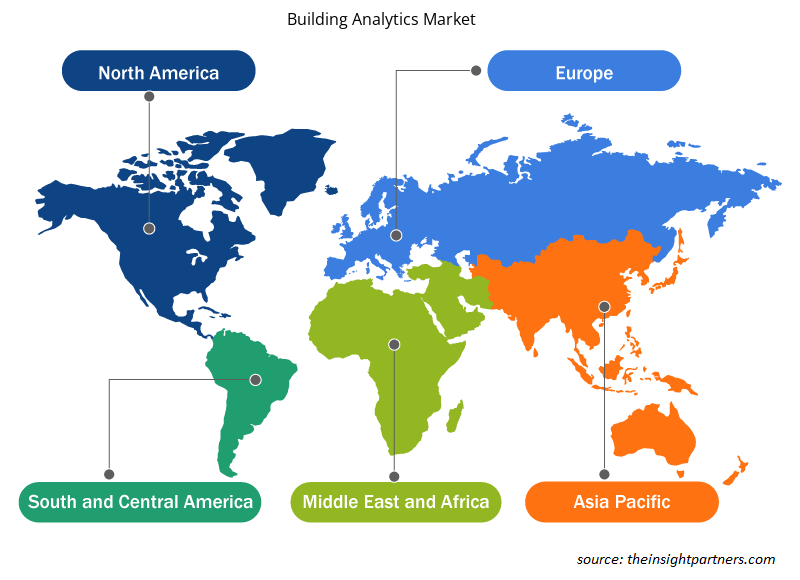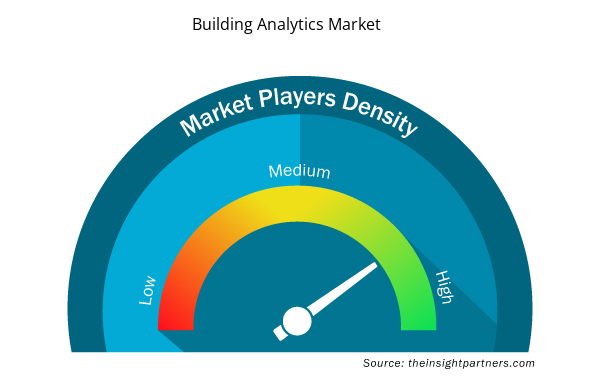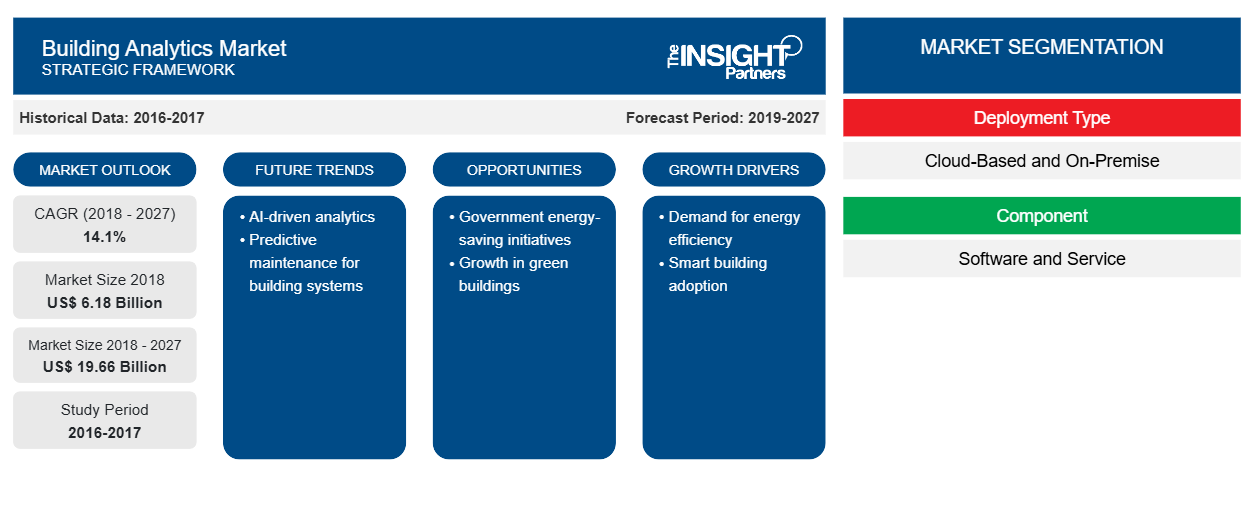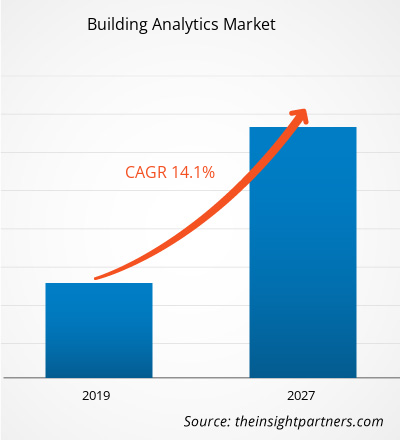بلغت قيمة سوق تحليلات البناء العالمية 6،181.4 مليون دولار أمريكي في عام 2018، ومن المتوقع أن تنمو بمعدل نمو سنوي مركب قدره 14.1٪ بين عامي 2019 و 2027.
يشهد سوق تحليلات البناء نموًا في جميع أنحاء العالم، ومن المتوقع أن تكون أسعار الطاقة المتزايدة والمبادئ التوجيهية الصارمة للطاقة في البناء وتحقيق أقصى قدر من الكفاءة التشغيلية لإدارة المباني والمرافق هي القوى الدافعة الرئيسية للسوق في السنوات القادمة.
يركز التقرير على تقسيم متعمق لسوق تحليلات المباني بناءً على نوع النشر والمكون ونوع المبنى والتطبيق. يغطي التقسيم الجغرافي للتقرير خمس مناطق رئيسية بما في ذلك؛ أمريكا الشمالية وأوروبا وآسيا والمحيط الهادئ (APAC) والشرق الأوسط وأفريقيا (MEA) وأمريكا الجنوبية (SA). تم تقسيم السوق الإقليمية بشكل أكبر حسب البلدان المعنية. حسب التطبيق، استحوذت إدارة الطاقة على أكبر حصة في سوق تحليلات المباني في عام 2018.
قم بتخصيص هذا التقرير ليناسب متطلباتك
ستحصل على تخصيص لأي تقرير - مجانًا - بما في ذلك أجزاء من هذا التقرير، أو تحليل على مستوى الدولة، وحزمة بيانات Excel، بالإضافة إلى الاستفادة من العروض والخصومات الرائعة للشركات الناشئة والجامعات
- احصل على أهم اتجاهات السوق الرئيسية لهذا التقرير.ستتضمن هذه العينة المجانية تحليلاً للبيانات، بدءًا من اتجاهات السوق وحتى التقديرات والتوقعات.
يهدف التقرير إلى تقديم نظرة عامة على سوق تحليلات البناء العالمية مع تقسيم السوق بالتفصيل. كما يحلل سيناريو سوق تحليلات البناء الحالي ويتوقع السوق حتى عام 2027. يغطي التقرير ديناميكيات السوق التي تؤثر على سوق تحليلات البناء خلال فترة التنبؤ. علاوة على ذلك، يحلل التقرير السيناريو التنافسي والاتجاهات الجغرافية والفرص في سوق تحليلات البناء فيما يتعلق بجميع المناطق الجغرافية. يتضمن التقرير أيضًا ملفات تعريف مفصلة للشركات الرئيسية في سوق تحليلات البناء جنبًا إلى جنب مع استراتيجيات السوق الخاصة بهم. يوفر التقرير أيضًا تحليل PEST جنبًا إلى جنب مع تحليل SWOT لجميع الشركات المذكورة في التقرير.
حاليًا، تعد معدلات اختراق سوق تحليلات المباني في منطقة أوروبا أعلى من أي أسواق أخرى في جميع أنحاء العالم. أنشأت توجيه كفاءة الطاقة في الاتحاد الأوروبي، الذي تم إطلاقه في عام 2012، مجموعة من التدابير الإلزامية لمساعدة الاتحاد الأوروبي على تحقيق هدف كفاءة الطاقة بنسبة 20٪ بحلول عام 2020. يتطلب التوجيه من جميع دول الاتحاد الأوروبي استخدام الطاقة بكفاءة أكبر في جميع أنحاء سلسلة الطاقة أي من الإنتاج إلى الاستهلاك النهائي. أيضًا، في عام 2016، تم اقتراح تحديث لتوجيه كفاءة الطاقة، والذي تضمن هدفًا جديدًا لكفاءة الطاقة بنسبة 30٪ لعام 2030، بالإضافة إلى تدابير لتلبية الهدف الجديد. في الاتحاد الأوروبي، تمثل المباني حوالي 40٪ من إجمالي استهلاك الطاقة و 36٪ من إجمالي انبعاثات ثاني أكسيد الكربون. أيضًا، حوالي 35٪ من المباني في الاتحاد الأوروبي يزيد عمرها عن 50 عامًا ونحو 75٪ من مخزون المباني غير كفء في استخدام الطاقة، على الرغم من أن 0.4-1.2٪ فقط من مخزون المباني يتم ترميمه كل عام. وبالتالي، فإن المزيد من ترميم المباني القائمة من شأنه أن يؤدي إلى توفير كبير في الطاقة. وتوفر هذه الحقائق فرصة مزدهرة لنمو سوق تحليلات المباني.
بناء رؤى إقليمية حول سوق تحليلات المباني
لقد قام المحللون في Insight Partners بشرح الاتجاهات والعوامل الإقليمية المؤثرة على سوق تحليلات البناء طوال فترة التوقعات بشكل شامل. يناقش هذا القسم أيضًا قطاعات سوق تحليلات البناء والجغرافيا في جميع أنحاء أمريكا الشمالية وأوروبا ومنطقة آسيا والمحيط الهادئ والشرق الأوسط وأفريقيا وأمريكا الجنوبية والوسطى.

- احصل على بيانات إقليمية محددة لسوق تحليلات البناء
نطاق تقرير سوق تحليلات البناء
| سمة التقرير | تفاصيل |
|---|---|
| حجم السوق في عام 2018 | 6.18 مليار دولار أمريكي |
| حجم السوق بحلول عام 2027 | 19.66 مليار دولار أمريكي |
| معدل النمو السنوي المركب العالمي (2018 - 2027) | 14.1% |
| البيانات التاريخية | 2016-2017 |
| فترة التنبؤ | 2019-2027 |
| القطاعات المغطاة | حسب نوع النشر
|
| المناطق والدول المغطاة | أمريكا الشمالية
|
| قادة السوق وملفات تعريف الشركات الرئيسية |
|
بناء كثافة اللاعبين في سوق التحليلات: فهم تأثيرها على ديناميكيات الأعمال
يشهد سوق تحليلات المباني نموًا سريعًا، مدفوعًا بالطلب المتزايد من المستخدم النهائي بسبب عوامل مثل تفضيلات المستهلكين المتطورة والتقدم التكنولوجي والوعي المتزايد بفوائد المنتج. ومع ارتفاع الطلب، تعمل الشركات على توسيع عروضها والابتكار لتلبية احتياجات المستهلكين والاستفادة من الاتجاهات الناشئة، مما يؤدي إلى زيادة نمو السوق.
تشير كثافة اللاعبين في السوق إلى توزيع الشركات أو المؤسسات العاملة في سوق أو صناعة معينة. وهي تشير إلى عدد المنافسين (اللاعبين في السوق) الموجودين في مساحة سوق معينة نسبة إلى حجمها أو قيمتها السوقية الإجمالية.
الشركات الرئيسية العاملة في سوق تحليلات البناء هي:
- شنايدر الكتريك
- شركة آي بي إم (IBM) العالمية للأعمال
- سكاي فاوندري
- الأنظمة البيئية، المحدودة
- شركة إنجي إنسايت سيرفيسز
إخلاء المسؤولية : الشركات المذكورة أعلاه ليست مرتبة بأي ترتيب معين.

- احصل على نظرة عامة على أهم اللاعبين الرئيسيين في سوق تحليلات المباني
بعض اللاعبين الرائدين العاملين في هذا السوق هم (حسب الترتيب الأبجدي) وهم: Acorn Engineering Group Limited، Arup Group، AT Kearney، Buildingiq، Buildinglogix، Buildpulse، Coppertree Analytics، Crestron Electronics، Delta Electronics، Ecovox، Energy Advantage، Enernoc، Engie Insight، Environmental Systems Inc.، General Electric، Gooee، Gridpoint، Honeywell، IBM Corporation، Iconics، Schneider Electric، Senseware، Siemens، SkyFoundry، Waibel Energy Systems، Xchanging PLC (CSC Computer Sciences International Operations Limited) وغيرها.
- التحليل التاريخي (سنتان)، السنة الأساسية، التوقعات (7 سنوات) مع معدل النمو السنوي المركب
- تحليل PEST و SWOT
- حجم السوق والقيمة / الحجم - عالميًا وإقليميًا وقطريًا
- الصناعة والمنافسة
- مجموعة بيانات Excel


- Emergency Department Information System (EDIS) Market
- USB Device Market
- Rugged Phones Market
- Flexible Garden Hoses Market
- Cling Films Market
- Compounding Pharmacies Market
- Pharmacovigilance and Drug Safety Software Market
- Greens Powder Market
- Digital Pathology Market
- Electronic Data Interchange Market

Report Coverage
Revenue forecast, Company Analysis, Industry landscape, Growth factors, and Trends

Segment Covered
This text is related
to segments covered.

Regional Scope
North America, Europe, Asia Pacific, Middle East & Africa, South & Central America

Country Scope
This text is related
to country scope.
Trends and growth analysis reports related to Technology, Media and Telecommunications : READ MORE..
The List of Companies
1. Schneider Electric
2. International Business Machines (IBM) Corporation
3. SkyFoundry
4. Environmental Systems, Inc.
5. ENGIE Insight Services Inc
6. Senseware, Inc.
7. Gooee
8. Acorn Engineering Group Limited
9. Waibel Energy Systems
10. BuildingIQ, Inc
11. Siemens AG
12. General Electric (GE)
13. Iconics, Inc.
14. Coppertree Analytics
15. Delta Electronics
The Insight Partners performs research in 4 major stages: Data Collection & Secondary Research, Primary Research, Data Analysis and Data Triangulation & Final Review.
- Data Collection and Secondary Research:
As a market research and consulting firm operating from a decade, we have published and advised several client across the globe. First step for any study will start with an assessment of currently available data and insights from existing reports. Further, historical and current market information is collected from Investor Presentations, Annual Reports, SEC Filings, etc., and other information related to company’s performance and market positioning are gathered from Paid Databases (Factiva, Hoovers, and Reuters) and various other publications available in public domain.
Several associations trade associates, technical forums, institutes, societies and organization are accessed to gain technical as well as market related insights through their publications such as research papers, blogs and press releases related to the studies are referred to get cues about the market. Further, white papers, journals, magazines, and other news articles published in last 3 years are scrutinized and analyzed to understand the current market trends.
- Primary Research:
The primarily interview analysis comprise of data obtained from industry participants interview and answers to survey questions gathered by in-house primary team.
For primary research, interviews are conducted with industry experts/CEOs/Marketing Managers/VPs/Subject Matter Experts from both demand and supply side to get a 360-degree view of the market. The primary team conducts several interviews based on the complexity of the markets to understand the various market trends and dynamics which makes research more credible and precise.
A typical research interview fulfils the following functions:
- Provides first-hand information on the market size, market trends, growth trends, competitive landscape, and outlook
- Validates and strengthens in-house secondary research findings
- Develops the analysis team’s expertise and market understanding
Primary research involves email interactions and telephone interviews for each market, category, segment, and sub-segment across geographies. The participants who typically take part in such a process include, but are not limited to:
- Industry participants: VPs, business development managers, market intelligence managers and national sales managers
- Outside experts: Valuation experts, research analysts and key opinion leaders specializing in the electronics and semiconductor industry.
Below is the breakup of our primary respondents by company, designation, and region:

Once we receive the confirmation from primary research sources or primary respondents, we finalize the base year market estimation and forecast the data as per the macroeconomic and microeconomic factors assessed during data collection.
- Data Analysis:
Once data is validated through both secondary as well as primary respondents, we finalize the market estimations by hypothesis formulation and factor analysis at regional and country level.
- Macro-Economic Factor Analysis:
We analyse macroeconomic indicators such the gross domestic product (GDP), increase in the demand for goods and services across industries, technological advancement, regional economic growth, governmental policies, the influence of COVID-19, PEST analysis, and other aspects. This analysis aids in setting benchmarks for various nations/regions and approximating market splits. Additionally, the general trend of the aforementioned components aid in determining the market's development possibilities.
- Country Level Data:
Various factors that are especially aligned to the country are taken into account to determine the market size for a certain area and country, including the presence of vendors, such as headquarters and offices, the country's GDP, demand patterns, and industry growth. To comprehend the market dynamics for the nation, a number of growth variables, inhibitors, application areas, and current market trends are researched. The aforementioned elements aid in determining the country's overall market's growth potential.
- Company Profile:
The “Table of Contents” is formulated by listing and analyzing more than 25 - 30 companies operating in the market ecosystem across geographies. However, we profile only 10 companies as a standard practice in our syndicate reports. These 10 companies comprise leading, emerging, and regional players. Nonetheless, our analysis is not restricted to the 10 listed companies, we also analyze other companies present in the market to develop a holistic view and understand the prevailing trends. The “Company Profiles” section in the report covers key facts, business description, products & services, financial information, SWOT analysis, and key developments. The financial information presented is extracted from the annual reports and official documents of the publicly listed companies. Upon collecting the information for the sections of respective companies, we verify them via various primary sources and then compile the data in respective company profiles. The company level information helps us in deriving the base number as well as in forecasting the market size.
- Developing Base Number:
Aggregation of sales statistics (2020-2022) and macro-economic factor, and other secondary and primary research insights are utilized to arrive at base number and related market shares for 2022. The data gaps are identified in this step and relevant market data is analyzed, collected from paid primary interviews or databases. On finalizing the base year market size, forecasts are developed on the basis of macro-economic, industry and market growth factors and company level analysis.
- Data Triangulation and Final Review:
The market findings and base year market size calculations are validated from supply as well as demand side. Demand side validations are based on macro-economic factor analysis and benchmarks for respective regions and countries. In case of supply side validations, revenues of major companies are estimated (in case not available) based on industry benchmark, approximate number of employees, product portfolio, and primary interviews revenues are gathered. Further revenue from target product/service segment is assessed to avoid overshooting of market statistics. In case of heavy deviations between supply and demand side values, all thes steps are repeated to achieve synchronization.
We follow an iterative model, wherein we share our research findings with Subject Matter Experts (SME’s) and Key Opinion Leaders (KOLs) until consensus view of the market is not formulated – this model negates any drastic deviation in the opinions of experts. Only validated and universally acceptable research findings are quoted in our reports.
We have important check points that we use to validate our research findings – which we call – data triangulation, where we validate the information, we generate from secondary sources with primary interviews and then we re-validate with our internal data bases and Subject matter experts. This comprehensive model enables us to deliver high quality, reliable data in shortest possible time.


 احصل على عينة مجانية لهذا التقرير
احصل على عينة مجانية لهذا التقرير